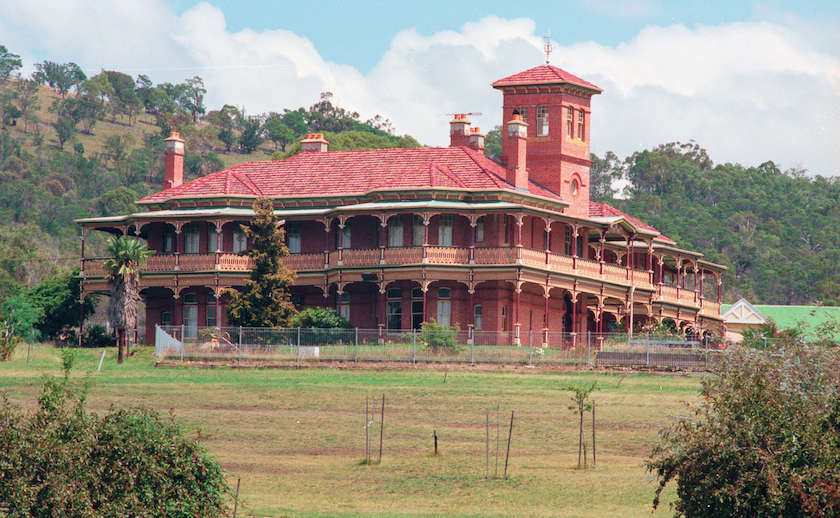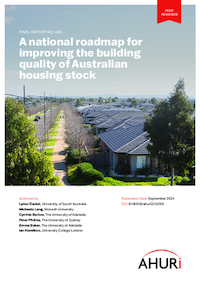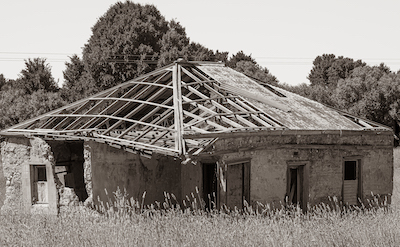Housing
Changing attitudes to housing

Wybra Hall, Bagdad, – Australia’s housing has changed since 1905
Some journalists treat rising house prices as an indicator of improving prosperity, in the same way as they regard rising share prices on the stock market. Such way of thinking seems to be well-entrenched. Twenty years ago John Howard said that he had never met anyone who complained about their house going up in value. In response to a question by the ABC’s Steve Austin about the overheated housing market he asserted:
Anybody who owns a house is very happy that the value of that house has gone up, let's be quite straight about that. I haven't found anybody in seven and a half years shake their fist at me and say Howard I'm angry with you for letting the value of my house increase.
Perhaps he was telling the truth, because John Howard eschewed the company of economists who could have explained to him the difference between inflation and real increases in value.
While rising share prices on the stock exchange generally reflect an improvement in the earning power of corporate assets – real increases in wealth – the same does not hold for rising house prices. It’s just inflation.[1]
In fact John Howard might like to have a chat with the 44 percent of homeowners with mortgages who want housing prices to go down.
That’s one of the findings of a Redbridge Poll, commissioned by Everybody’s Home, on attitudes to housing prices and housing policies. Only one in five people surveyed want house prices to increase. Everybody’s Home spokesperson Maiy Azize explains the poll’s main findings, which confirm attitudes surveyed by other pollsters, in a 9-minute interview on Radio National: Most Aussies want house prices to fall, poll shows.
Housing affordability has been an issue for a long time, but now it trumps the illusion of rising house values as a concern in the community.
Most people want to see the government implement more drastic solutions to housing affordability than those being considered by governments. Almost half of respondents want to see negative gearing restricted to one property.[2]
Coinciding with the Everybody’s Home poll, there has been a YouGov poll, with slightly different questions but coming to the same conclusions, as summarized by the ABC’s Jason Whittaker: Build more rentals, end tax breaks, let values fall: Australians tell government how to fix housing. Only 11 percent of respondents believe a 5 percent fall on housing prices would be a bad thing (are the property spruikers listening?). Like the respondents to the Everybody’s Home poll, the YouGov respondents want to see a restoration of funding for social housing and abolishment of negative gearing.
A majority of respondents also want to be able to access superannuation to buy a home. Most economists would warn against this: such a policy would be detrimental for young people as they age. Economists would also be cautious about the call by respondents to the Everybody’s Home poll to reduce the capital gains discount for property speculators. It would be far better if capital gains applied to the real (inflation-adjusted) gain without any discount, which was the case before the Howard government wrecked the capital gains tax system in 1999.
In a post on the ABC website Patricia Karvelas suggests that the public are ready to accept a reform of tax breaks privileging housing in a way that we weren’t when Shorten took a bunch of proposals to the electorate, and didn’t win office: In 2019, Australia wasn't ready to talk about tax and housing. Is now finally the time to talk about negative gearing?.
Many election analysts disagree with the established political wisdom that the policies Labor took to the electorate were too bold. There were many reasons for Labor’s loss in 2019. One is that their tax policies, although well-intentioned, had been designed on the run and were therefore difficult for Labor to explain. In fact their specific proposals on imputation and capital gains seem to have been drafted by people with little understanding of taxation policy. They would have encouraged housing speculation, and the proposals on imputation would have been easy to evade by the rich, while hitting many people of modest means very hard.
If there’s a lesson for Labor in its 2019 defeat it’s to put more care into policy proposals. But unfortunately the lesson it seems to have drawn, that has frozen the government into excess political risk aversion, is that people are afraid of tax reform.
1. To allow for nitpickers: short-term movements in share prices are generally just noise, but long-term prices are about an improved present value of future earnings. And if the quality of houses improves, there will be a rise in real value, but the influence of such improvement is minor. ↩
2. No need to stop at one property: zero is better. There is no economic justification for allowing the full deduction of interest as an expense offsetting income, because it involves double-counting of interest and depreciation, but that’s the subject of a lecture in advanced accounting. ↩
Who is to blame for unaffordable housing?
Within the two main parties, negative gearing and capital gains tax concessions hardly get a mention as drivers of house price inflation. The Coalition doesn’t want to remind the electorate that it has vehemently defended these tax breaks in election campaigns, and Labor doesn’t want to scare the horses, as covered in the post above.
So the Coalition’s first line of attack is to blame the government for making housing unaffordable, and for making life hard for mortgage holders, asserting that the government is operating a loose fiscal policy, which has left it to the Reserve Bank to fight inflation by raising interest rates. Its second line of attack is to blame Labor for not restricting immigration further.
The ABC’s Jason Whittaker covers this political fight in his post: Housing crisis “despair” as opposition says government is looking for “scapegoats”.
He runs the Coalition’s claims about fiscal extravagance and excess immigration past experts, and finds they do not stand up to scrutiny. Housing Minister Claire O’Neil points out that problems of housing affordability have been building up for 25 years.
In a Conversation article Martin Loosemore and Suhair Alkilani remind us that immigrants not only demand houses: they can also build houses (as they did in the years after 1945 when immigration in relation to our population was running at a much higher rate than it is now): Australia’s construction industry needs more hands on deck – so why is it ignoring skilled migrant women?.
But we’re generally not making use of immigrants’ skills, not only because of gender and racial discrimination, but also because we don’t recognize qualifications immigrants have gained in other countries. They point out that “migrants who arrived in Australia in the past five years account for only 2.8 percent of Australia’s construction workforce, but 4.4 percent of the entire Australian workforce”.
China in particular would seem a natural country to turn to for construction skills, in light of the downturn in its construction industry.
Strata titles
If you’re moving into a large apartment building, choose one where you will have at least one corporate lawyer, one forensic accountant and preferably one senior employee of the ACCC as neighbours.

Who’s managing it?
That’s a conclusion to be drawn from the ABC Four Corners program The strata trap. It’s a story of consumer exploitation through exorbitant commissions, conflicts of interest, deliberately opaque contracts and weak regulation.
It covers two aspects of exploitation where strata managers are not acting in the interests of property owners. That is, that the people who employ them.
One is through the relationship between strata managers and builders. They should be entirely separate, but they aren’t. That’s why there are often outrageous charges for small maintenance jobs, and why strata managers go easy on builders who should be responsible for rectifying faults resulting from poor construction.
The other is through high charges for insurance, which result from strata managers receiving hefty commissions from insurers, who often have a close relationship with the strata management companies.
The behaviour depicted in the Four Corners program is bullying, deceitful and almost certainly illegal, but the strata management firms have deep pockets into which they can dip to fend off legal challenges. That is, the fees they collect from owners are used to defend strata managers’ interests against owners’ interests. Their manipulation of body corporate meetings and elections suggests they have learned their tactics from the Belarus election office.
This is against the backdrop of increasing concentration in the strata management and insurance industries, a concentration that had not come to the attention of the ACCC until the ABC’s exposure.
Also there is weak regulation. The program is mainly about problems in New South Wales, which claims to have the best regulation of any state.
Much of the content of the Four Corners program is on an ABC website, prepared by Linton Besser, Mayeta Clark and Echo Hui: Strata companies' hidden fees, secret kickbacks and developer deals costing apartment owners. That cost is a significant part of the $7 billion the strata management firms collect from apartment owners each year.
In response to the Four Corners revelations Gina Cass-Gottlieb, Chair of the ACCC, has called for a ban on strata insurance commissions, and a coalition of groups including Choice, the Owners’ Corporation Network and the Australian Consumers Insurance Lobby has written to Treasurer Chalmers requesting the government to direct a special ACCC or Productivity Commission inquiry into the strata management industry.
Housing quality
Imagine if our cars had the same quality shortcomings as our houses. Most of them would have significant faults affecting their performance, comfort and safety, many of which would have been present when the car was driven out of the showroom, and their poor fuel efficiency would be costing owners a packet.

That’s roughly a description of Australia’s housing stock, described in a report by the Australian Housing and Urban Research Institute (AHURI): A national roadmap for improving the building quality of Australian housing stock.
They found that while more than half of our homes are of good or excellent quality, 70 percent have some quality problems, including cracks, mould and plumbing issues.
What might be most costly for owners over the long term is the poor environmental performance of Australian homes, revealed in AHURI’s research. There is slow improvement, however, as new homes are built to higher energy standards. (The Guardian’s Josh Nicholas has a recent article quantifying our home insulation standards: Why so many Australian homes are either too hot or too cold.)
AHURI calls for national policies to improve residential building standards in three areas: improved performance standards for new houses, mandatory disclosure of dwelling energy performance, and minimum housing standards for the rental sector.
The ABC’s Ahmed Yussuf has a short article summarising AHURI’s work, drawing on AHURI’s lead author Lyrian Daniel. She reports that our regulations on building standards are lagging behind those of other “developed” countries, and that all over the world housing is coming under greater physical stress because of climate change.
Is the housing bubble deflating?
Probably not, but the rate of inflation in housing prices is slowing down. The latest CoreLogic index shows that in the 12 months to August home values actually fell in Melbourne and Hobart, rose by less than CPI inflation in Canberra (i.e. fell in real terms), and were just ahead of inflation in Sydney, while rising substantially in Adelaide and Perth.

Deflated house
What may be happening is a long-expected “regression to the mean”. That is, the market is creeping its way to something closer to a national uniform price (although Sydney Harbour will always command a premium over the River Torrens.)
CoreLogic has a research note specifically on Melbourne prices: How did Melbourne’s median dwelling value become sixth lowest across the Australian capitals?. There are many factors, some to do with interstate migration, but the main reason for lowering prices in Melbourne is that a large proportion of its housing stock is multi-unit – a much larger proportion than in Adelaide and Perth. Melbourne is making progress in densification in a way that Adelaide and Perth aren’t, as can be confirmed from a peek from an airplane window or a high vantage point. Public policy on zoning, a state and local government responsibility, clearly plays a part in housing supply.
There is nothing new in conflicts about zoning. But the NIMBY movement is now being challenged by a growing YIMBY movement, as Queensland ABC journalists illustrate: “Nimbyism” threatening delivery of affordable housing in Queensland, experts say.